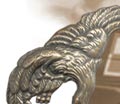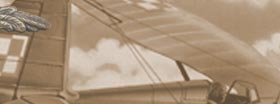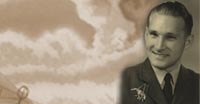V Weapons Hunt: Defeating German Secret Weapons.
By Colonel Roy M. Stanley II, USAF (Ret) (2010), Pen and Sword Military.
UK ISBN 978 1 84884 259 5
Roy Stanley dedicates his book to the skills of those whose war effort was to interpret photos, which developed into the ‘Photo Interpretation Report’ as military intelligence ‘science’ to search out and assist in the destruction of V weapons. The book outlines the Allied operations and campaigns to halt the physical and psychological impact of V weapons falling on Britain. The book has a personal connection in that my father flew for the 303 Squadron with many of his missions over northern France and Holland to identify V1 and VII sites. He was the first person to be accredited in reporting the con-trails of the VII.
Roy Stanley opens the book with a review of the need for the Allies to build ‘guided’ bombs while Nazi Germany sought ‘smart bombs’ technology as a more strategic weapon rather than the reliance upon blanket bombing activities against both civilian and military targets. The book develops an insight into the history of aerial photography from its inception in the First World War at Heston in Britain through to the development of interpretation techniques as a systematic series of phases. These included the use of transparent traces to track changes through overlays. By identifying any alteration to topography the photo analysts developed aerial photography into an essential tool for hunting down the V sites. The story of aerial photography charts the ‘history’ of not only the intelligence gathering techniques, but also the locations the units were based and adds important detail for local historians interested in the ‘archaeology’ of WW2.
The joy of reading this book lies in Roy Stanley’s ability to write and communicate technical details for the lay reader to understand. The hunt for the V weapons and the detailed analysis from a photo interpreters viewpoint chases the development of V weapons from Peenemünde on the Baltic coast through to Blizna in Poland where the VII rocket parts were successfully smuggled out of Poland by the AK (Polish Underground army) in a daring mission. The quality of the photos and the author’s analytical comments animate the story of the hunt, but also the skill of the interpreters to identify the cunningly well disguised launch sites are appraised too.
Colonel Roy M. Stanley II has crafted a well-written authoritative work and adds an alternative dimension to this period of history. In the closing chapter there is an attempt to assess how the Nazis mismanaged their new technologies in the Vengeance weapons programme. It is quite clear that in the closing stages of the war the VII assault on Britain would become less effective. The trajectory across the North Sea reduced the potential targets, but also the RAF and the Polish Air Force flew regular missions over Belgium and Holland to curtail the launch opportunities (quite often in residential areas), which is when the VII’s were most vulnerable.
Julian Hoseason, editor polandinexile.com





